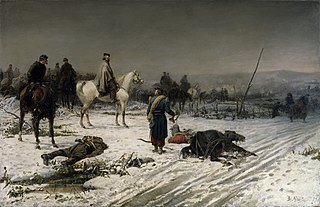
Dijon is a city that serves as the prefecture of the Côte-d'Or department and of the Bourgogne-Franche-Comté region in eastern France. As of 2017 the commune had a population of 156,920.

The French Revolutionary Wars were a series of sweeping military conflicts resulting from the French Revolution that lasted from 1792 until 1802. They pitted France against Great Britain, Austria, Prussia, Russia, and several other countries. The wars are divided into two periods: the War of the First Coalition (1792–1797) and the War of the Second Coalition (1798–1802). Initially confined to Europe, the fighting gradually assumed a global dimension. After a decade of constant warfare and aggressive diplomacy, France had conquered territories in the Italian Peninsula, the Low Countries and the Rhineland. French success in these conflicts ensured the spread of revolutionary principles over much of Europe.

Belfort is a city in northeastern France, situated approximately 25 km (16 mi) from the Swiss border. It is the prefecture of the Territoire de Belfort.

The War of the Second Coalition was the second war targeting revolutionary France by many European monarchies, led by Britain, Austria, and Russia and including the Ottoman Empire, Portugal, Naples and various German monarchies. Prussia did not join the coalition, while Spain supported France.

Auxonne is a commune in the Côte-d'Or department in the Bourgogne-Franche-Comté region of eastern France.
The Napoleonic Wars continued from 1799 with the French fighting the forces of the Second Coalition. Napoleon Bonaparte had returned from Egypt and taken control of the French government, marking the end of the French Revolution. He prepared a new campaign, sending Moreau to the Rhine frontier and personally going to take command in the Alps, where French forces had been driven almost out of Italy in 1799.

The War of the League of Cambrai, sometimes known as the War of the Holy League and several other names, was fought from February 1508 to December 1516 as part of the Italian Wars of 1494–1559. The main participants of the war, who fought for its entire duration, were France, the Papal States, and the Republic of Venice; they were joined at various times by nearly every significant power in Western Europe, including Spain, the Holy Roman Empire, England, the Duchy of Milan, the Republic of Florence, the Duchy of Ferrara, and the Swiss.

Dijon-Prenois is a 3.801 km (2.362 mi) motor racing circuit located in Prenois, near Dijon, France. The undulating track is noted for its fast, sweeping bends.

Valenza is a comune (municipality) in the Province of Alessandria in the Italian region Piedmont, located about 80 kilometres (50 mi) east of Turin and about 11 kilometres (7 mi) north of Alessandria, in the extreme Montferrat’s offshoots, in the Lombardy’s border.

The third siege of Girona occurred in northern Catalonia, Spain from 6 May to 12 December 1809, during the Napoleonic Wars. A significant event of the Peninsular War, France's Grande Armée lay siege to the town of Girona for seven months. Girona was strategically important because it controlled the main road between France and Spain.

Gaspard de Saulx, sieur de Tavannes was a French Roman Catholic military leader during the Italian Wars and the French Wars of Religion. He served under four kings during his career, participating in the Siege of Calais (1558) and leading the royal army to victory in the third civil war at the Jarnac and Moncontour. A strong Catholic, he founded the confraternity of the holy ghost in 1567 which would be a template for other militant Catholic organisations across France. He died in 1573, shortly after the opening assassinations of the Massacre of Saint Bartholomew, which he had helped plan.

The Free City of Danzig, sometimes referred to as the Republic of Danzig, was a semi-independent city-state established by Napoleon on 9 September 1807, during the time of the Napoleonic Wars following the capture of the city in the siege of Danzig in May. After the Congress of Vienna of 1814–1815, Danzig was re-incorporated into the Kingdom of Prussia.

The 1975 Swiss Grand Prix was a non-championship Formula One race held on 24 August 1975 at the Dijon-Prenois racetrack near Dijon, France. Circuit racing in Switzerland had been banned after the 1955 Le Mans disaster, whereas the 1975 French Grand Prix was held at Circuit Paul Ricard.

The Army of the Vosges was a volunteer force placed under the command of Giuseppe Garibaldi, formed in order to ensure the defense of the road to Lyon from the Prussian Army during the Franco-Prussian war.

Terrot was a motorcycle manufacturer in Dijon, France.

The Peace of Lund, signed on 16 September (O.S.) / 26 September 1679, was the final peace treaty between Denmark–Norway and the Swedish Empire in the Scanian War.

The Battles of Dijon were a series of battles that took place in 1870 and 1871, as part of the Franco-Prussian War, on the current territory of the French commune of Dijon between the French Republic and the German states of Prussia and Baden and later, the German Empire.
The Battle of Châteauneuf was a battle in the Franco-Prussian War that took place on December 3, 1870, at the Châteauneuf-sur-Loire, Loire, France. During this engagement, the 3rd Infantry Brigade of the Prussian army, which was a part of the Baden Division and was under the command of General Keller repelled an ambush of the French army under the command of General Camille Crémer. The battle facilitated the Prussian army to continue its withdrawal from Autun. The battle lasted for seven hours, and brought the Prussian army negligible losses, with 153 casualties. However, the Germans viewed this engagement as one of their most glorious victories of the campaign.















